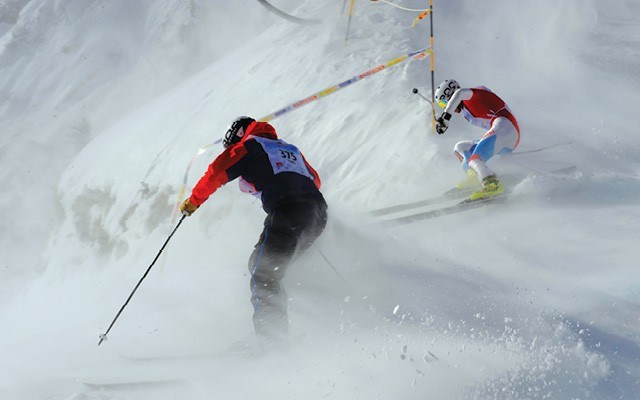I am trying to imagine what it's like to be 1,900th out of the gate at a downhill race. Or even 1,000th for that matter. But I don't have to, because racer 1,000 just passed me. Legs akimbo, chattering off rock-hard washboard compressions, a look of pained horror on his face, this guy is only halfway down and will be lucky to make it alive. At this point, if he allows those burning thighs to slow him for even a second, he'll be overtaken, possibly even plowed into, by another racer.
That's the way it goes during The Inferno in Mürren, Switzerland, the world's oldest and largest amateur downhill race. It's 74th iteration takes place this January.
The first Inferno was run here by ski-writing legend Arnold Lunn's Kandahar Ski Club in 1928. From the summit of the toothy Schilthorn, the course drops some 2,600 vertical metres and 13 kilometres through nested bowls, off-camber ridges and forest to the town of Lauterbrunnen. In the early days, participants climbed three hours from Mürren on skis and spent the night in a hut, then climbed three more hours to the Schilthorn start gate the next morning. The 1928 winner took one hour 45 minutes to reach the valley; the next year, with a known route and more racers beating down the snow, a young James Riddell — another ski-writing great — did it in 45 minutes. Today the fastest racer takes less than 15 minutes. With one of 1,900 leaving the gate every 12 seconds, the event is now pure madness — and more than occasional disaster. That's a lot of people but only half as many as actually want to sign up for what has become the economic lifeblood of a fabled ski town in the Jungfrau region of the Swiss Alps.
Leading up to the race, Lycra racing suits are common in Mürren's streets and bars, and every ski shop has ex-World Cup downhill boards for rent. Racers must complete a cross-country race through the townsite if they want to qualify for the "combined" category. That was fun enough to watch, but the night before the gun went off for the downhill, these same streets saw a snaking parade of torch-bearers, costumed marching bands, and an enormous papier-maché devil's head that echoed iconography seen in the windows of every establishment in town. Fuelled by tea and schnapps, the parade pulled up at the sport complex fronting the magnificent Alpin Palace Hotel, the place that kick-started the entire idea of ski resorts back in 1910. Here, speeches were given, starting numbers drawn, and more schnapps consumed — mostly by the racers (though it was nothing like the partying that would happen after the seven-hour race concluded the next afternoon).
Around 9 a.m., the race got underway in the shadow of the Schilthorn, under a chic revolving restaurant that caps the lift station where famous scenes from the James Bond film, On Her Majesty's Secret Serviceˆ, were filmed. There were plenty of George Plimptons on hand (journalists looking to capture the race's "feel" by participating), including my friend Patrick Leije, editor of Sweden's Åka Skidor; he was in a first wave of 100 forerunners that took only a few minutes to leave the start gate. There was a short break and then the truly competitive racers got set, the top seeds going first. After a dozen or so, ruts were already showing on the first fall-away gate, and several racers almost lost it at very high speeds. I was sure someone would go highside on the sweeping right-hander and hit the fence, and they did just that. It was the first of many bad crashes, but at least that one walked away. By 10:15 a.m., the sound of helicopters evacuating the injured was almost constant while the race worked its way through those dozens who fancied themselves a Hermann Maier or Bode Miller.
The Cannonball — the steep, off-camber section where I viewed racer No. 1,000 stagger through, upright against all odds — was especially dangerous. Beside me, a guy who raced it in the 1960s said people used to slide down The Cannonball on their asses — the fastest way when there was no piste and clumsy zig-zagging would have been required. But there's still plenty of fancy footwork required in this crazed competition. Strangely, for a downhill, there are even uphill sections that require skating and poling. Only a few hundred metres, but enough for some skiers to carry cross-country style poles. You can't win the race here, but you can certainly lose it.
Of course, it doesn't matter where you place in the race, because everyone is a winner at the after-party, which starts on the mountain and rages until 5 a.m. at the Hotel Eiger, where the bruised and battered, it seems, do as much — or more — damage than on the hill. Whose idea was this madness? Most stagger out of that affair, whether on crutches or under their own power, feeling like they've been to hell and back. And the first thing they see outside the hotel? A monument to the devil himself: Arnold Lunn.
Leslie Anthony is a Whistler-based author, editor, biologist and bon vivant who has never met a mountain he didn't like.




